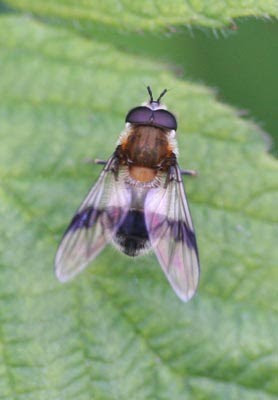This shot of a male Andrena sp. solitary bee shows the triangle of three extra 'eyes' that lie between the two main eyes. These ocelli are very sensitive to rapid changes in light, and are used to detect movement, whereas the main eyes are slower and are used for navigation and object recognition:

Larger Ichneumonids are now a fairly regular sighting along the hedgerows. They fly slowly under leaves looking for their host caterpillars:
 Most Sawflies are tied to a particular plant or family of plants, so I'd bet on this one being a Bramble feeder.
Most Sawflies are tied to a particular plant or family of plants, so I'd bet on this one being a Bramble feeder.
 The only blue Chrysomelid that I'm aware of is dependent on Willow, which is close by, so maybe it was just on holiday.
The only blue Chrysomelid that I'm aware of is dependent on Willow, which is close by, so maybe it was just on holiday.
The Snipe Fly Rhagio scolopacea is known as the 'Downlooker' due to its more usual habit of hanging vertically, facing downwards waiting for prey to fly past. This is a male:
Hoverflies are some of our most handsome (and useful! - they pollinate flowers, trees and crops) insects. This is a male Leucozona lucorum:
Sawflies - closely related to wasps and bees - remain shrouded in mystery. They are strictly vegetarian as larvae (indeed some are considered to be crop pests), but largely carnivorous as adults. The larvae closely resemble the caterpillars of moths and butterflies, but many remain unidentified. The existing reference documentation is very old, and I feel that these must be the next area for extensive research and documentation. Note: the ocelli are also visible on this one that I found wandering over Bramble:
 Most Sawflies are tied to a particular plant or family of plants, so I'd bet on this one being a Bramble feeder.
Most Sawflies are tied to a particular plant or family of plants, so I'd bet on this one being a Bramble feeder.A bright blue Chrysomelid beetle, also wandering over Bramble:
 The only blue Chrysomelid that I'm aware of is dependent on Willow, which is close by, so maybe it was just on holiday.
The only blue Chrysomelid that I'm aware of is dependent on Willow, which is close by, so maybe it was just on holiday.A few moths are still coming to light, despite the cold evenings. This is May Highflyer - Hydriomena impluviata:





2 comments:
"These ocelli are very sensitive to rapid changes in light, and are used to detect movement, whereas the main eyes are slower and are used for navigation and object recognition"
Fascinating - but how do you know that?
"but how do you know that?"
There are numerous papers about the subject.
This one discusses fast light response of ocelli to assist orientation with the horizon:
http://jeb.biologists.org/cgi/reprint/83/1/351.pdf
This one discusses the particular properties of the ocelli and concludes that they are 'wide-field brightness sensors':
http://kyb.tuebingen.mpg.de/publications/pdfs/pdf1298.pdf
There's a lot of information and theory out there.
Post a Comment